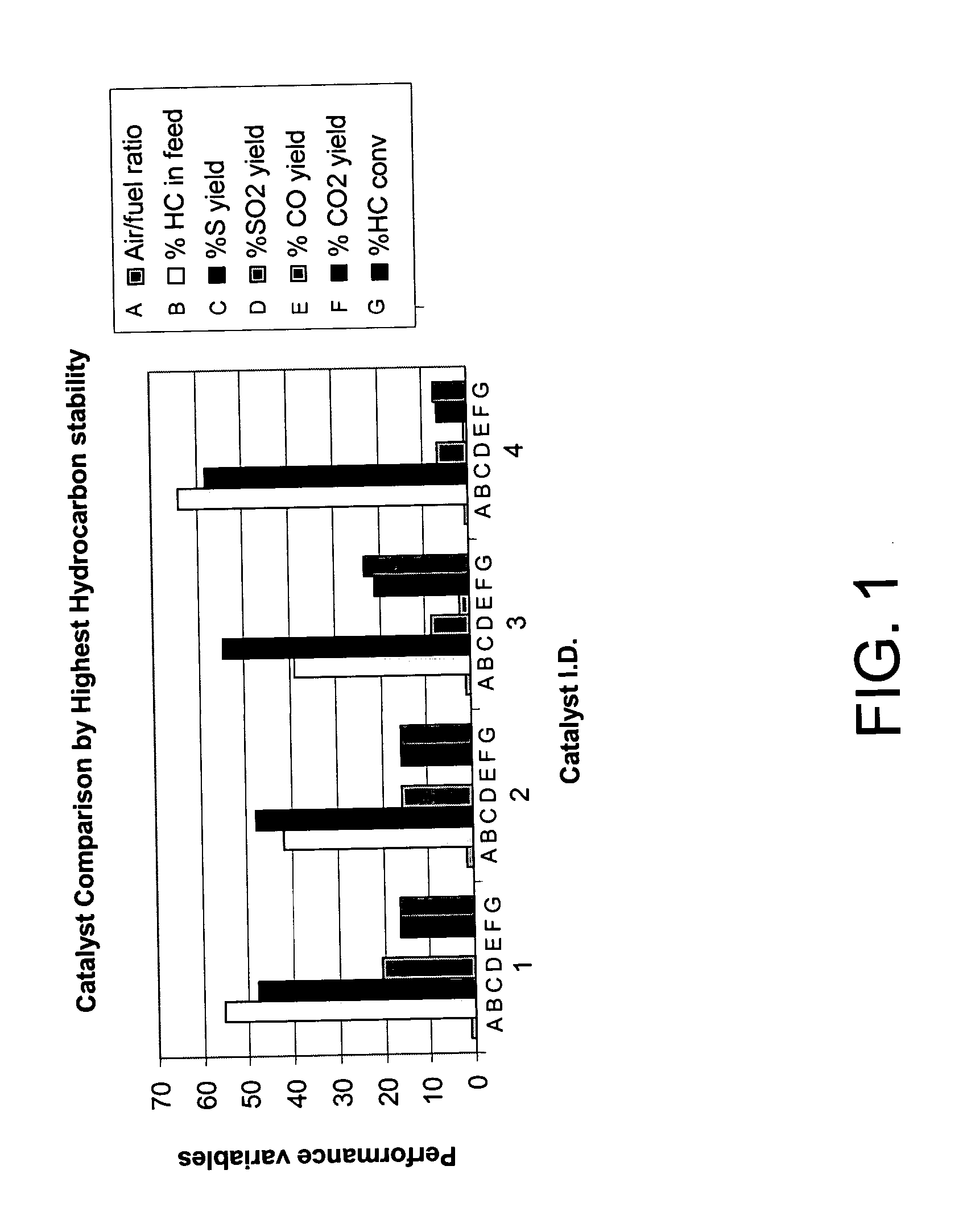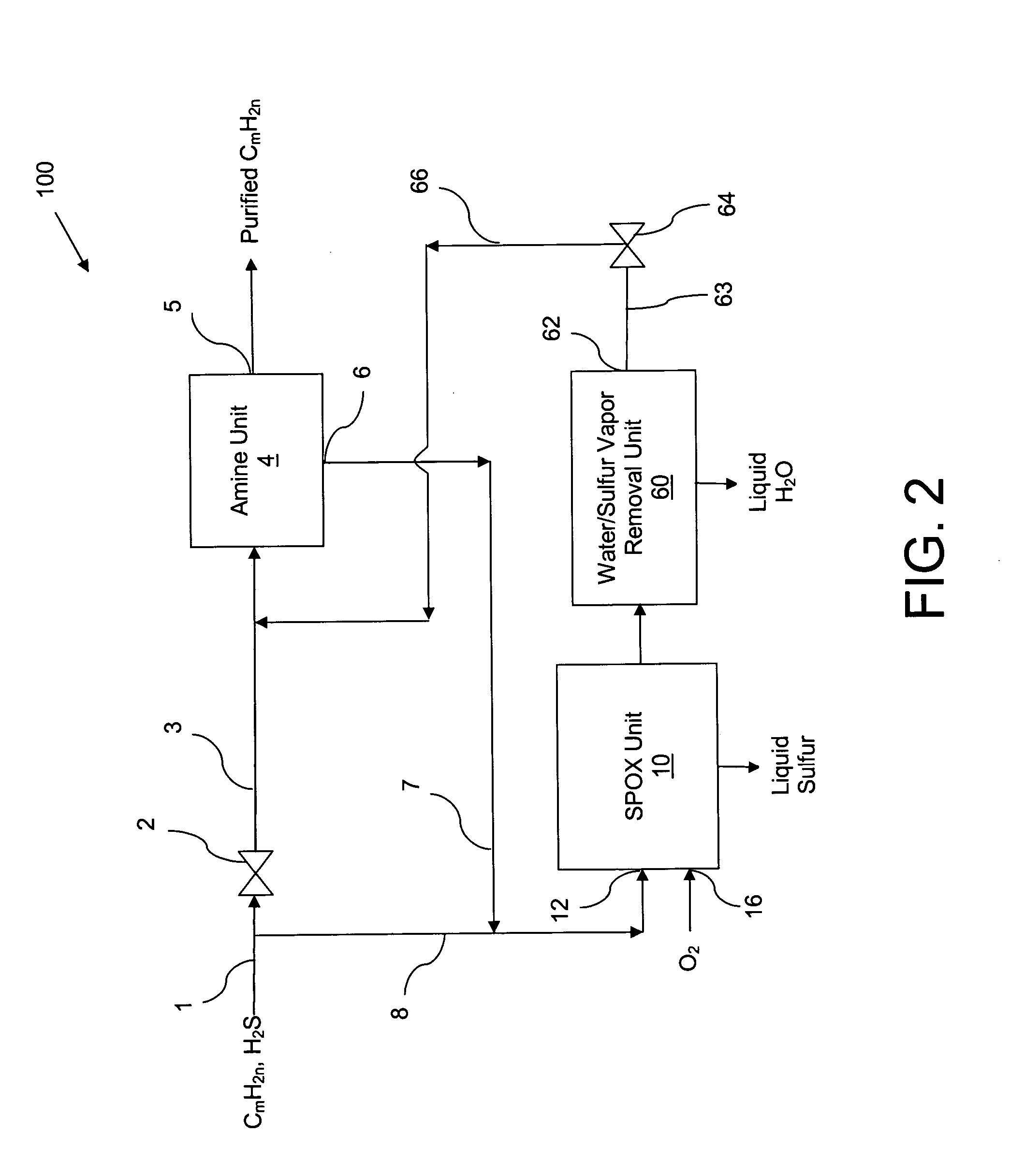Apparatus and catalytic partial oxidation process for recovering sulfur from an H2S-containing gas stream
a technology of partial oxidation and apparatus, which is applied in the direction of physical/chemical process catalysts, separation processes, sulfur preparation/purification, etc., can solve the problems of forming undesirable sulfur compounds, h2s-positive odor, and difficult to detect odor, so as to efficiently and selectively convert higher concentrations of h2s
- Summary
- Abstract
- Description
- Claims
- Application Information
AI Technical Summary
Benefits of technology
Problems solved by technology
Method used
Image
Examples
example 1
Synthesis of an H2S Selective Catalyst
[0054] A preferred representative catalyst comprising Pt / Rh / Ir / Sn / Mg supported on MgO granules (Catalyst-4) was prepared as follows: [0055] a. 20-30 mesh MagChem 10 MgO granules obtained from Martin Marietta Magnesia Specialties, MD were calcined at 1000 C in air prior to loading catalyst metals on them. [0056] b. On 10 gram batch of calcined MgO granules, 2 wt % Mg was impregnated using magnesium nitrate precursor dissolved in distilled, de-ionized water. After drying with continuous stirring on hot plate at 70° C. to remove excess water, the material was calcined under air flow at 125° C. for 1 hour, 350° C. for 1 hour and 700° C. for 3 hours. This procedure resulted in coating MgO granules with a layer of MgO to form the base for subsequent metal loading and to increase the surface area. [0057] c. Next, using the above procedure 0.5 wt % Ir was loaded on the final material from step (b), using iridium chloride precursor. The final calcinatio...
example 2
Test Procedure for Evaluating Catalyst Performance
[0062] The catalyst was evaluated for its ability to catalyze the catalytic partial oxidation of methane and the catalytic partial oxidation of hydrogen sulfide in a modified conventional flow apparatus using a quartz reactor with a length of 12 inches, an outside diameter of 19 mm and an inside diameter of 13 mm. Ceramic foam pieces of 99% Al2O3 (12 mm outside diameter×5 mm thick, with 45 pores per linear inch) were placed before and after the catalyst as radiation shields. The catalyst bed including the radiation shields was approximately 12 mm in diameter×8 cm in height, and contained about 3 grams of catalyst granules. The inlet radiation shield also aided in uniform distribution of the feed gases. An Inconel-sheathed, single point K-type (Chromel / Alumel) thermocouple was placed axially inside the reactor, touching the top (inlet) face of the radiation shield. A high temperature S-Type (Pt / Pt 10% Rh) bare-wire thermocouple was p...
PUM
| Property | Measurement | Unit |
|---|---|---|
| temperature | aaaaa | aaaaa |
| temperature | aaaaa | aaaaa |
| temperature | aaaaa | aaaaa |
Abstract
Description
Claims
Application Information
 Login to View More
Login to View More - R&D
- Intellectual Property
- Life Sciences
- Materials
- Tech Scout
- Unparalleled Data Quality
- Higher Quality Content
- 60% Fewer Hallucinations
Browse by: Latest US Patents, China's latest patents, Technical Efficacy Thesaurus, Application Domain, Technology Topic, Popular Technical Reports.
© 2025 PatSnap. All rights reserved.Legal|Privacy policy|Modern Slavery Act Transparency Statement|Sitemap|About US| Contact US: help@patsnap.com



